Table of Contents
- 1 What is Utility Analysis?
- 2 Definitions Of utility
-
3 Characteristics of Utility
- 3.1 Utility Is Not Related With Usefulness or Welfare
- 3.2 Utility is Measurable
- 3.3 Utility is a Relative Term
- 3.4 Utility is Subjective
- 3.5 Utility Depends on the Intensity of Want
- 3.6 Utility is Concerned with Consumer Goods Only
- 3.7 No Physical Shape
- 3.8 Utility Does Not Depend on Actual Consumption
- 3.9 Rationality of the Consumer
- 4 Features of Utility
- 5 Concepts of Utility
- 6 Measurement of Utility
- 7 Law of Diminishing Marginal Utility
- 8 Law of Equi-Marginal Utility
- 9 FAQ
What is Utility Analysis?
Utility analysis, a subset of consumer demand theory, provides insight into an understanding of market demand and forms a cornerstone of modern microeconomics. In particular, this analysis investigates consumer behaviour, especially market purchases, based on the satisfaction of wants and needs (that is, utility) generated from the consumption of a good.
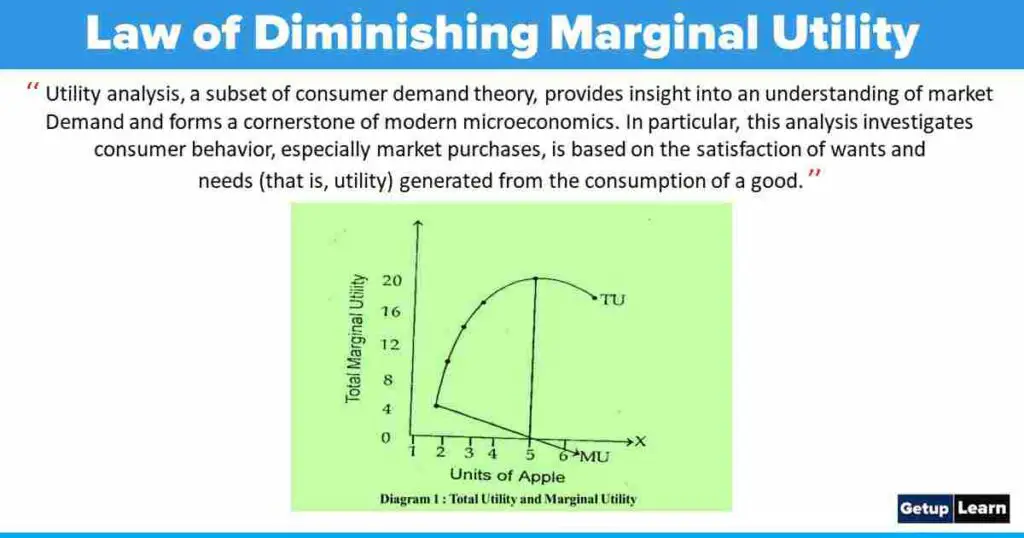
Table of Contents
The term utility in Economics is used to denote the quality of a good or service by virtue of which our wants are satisfied. In, other words utility is defined as the want satisfying power of a commodity. According to, Mrs Robinson, “Utility is the quality in commodities that makes individuals want to buy them.”
Definitions Of utility
These are some of the definitions of utility by authors:
[su_quote cite=”Prof. Alfred Marshall”]The utility of a thing to a person at a time is measured by the extent to which it satisfies his wants.[/su_quote]
[su_quote cite=”Prof. S.E Thomas”]So long as an article satisfies man’s desire of body or mind, it possesses utility in the economic sense, although this may be pernicious in its effect on the consumers or on others or detrimental to the commodity generally.[/su_quote]
[su_quote cite=”Prof. Lipsey and Prof. Sticner”]The satisfaction that someone receives from consuming commodities is called his utilit[/su_quote]
Characteristics of Utility
The following are characteristics of utility which are discussed below:
- Utility Is Not Related With Usefulness or Welfare
- Utility is Measurable
- Utility is a Relative Term
- Utility is Subjective
- Utility Depends on the Intensity of Want
- Utility is Concerned with Consumer Goods Only
- No Physical Shape
- Utility Does Not Depend on Actual Consumption
- Rationality of the Consumer
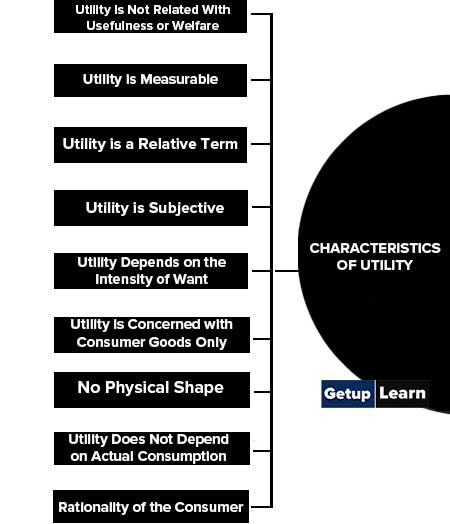
The utility is the name given to the power of satisfying human wants, whether want is good or bad, welfare or non-welfare, supply of the commodity will be beneficial or harmful all immaterial issues. Excess use of wine may be harmful from the society’s point of view, but it has utility for consumers because its consumption provides mental satisfaction. Thus utility is not related to usefulness.
Utility is Measurable
The utility is measurable in terms of money. When a consumer is purchasing a commodity he is sacrificing in terms of money and this sacrifice is the measurement of utility. Keeping in view this, the relative measurement of utility of two goods is also possible.
The utility is based on the cardinal approach and wherein utility is measured in terms of money. It can be added, subtracted and multiplied as well.
Utility is a Relative Term
The concept of utility is relative and not absolute. The utility of a commodity depends on the consumer’s want and the want satisfying power of a commodity. A glass of water has more utility when a person is thirsty but when he is not thirsty, the glass of water has no utility.
A book of general knowledge has utility for a student who is appearing in a competitive examination but for an illiterate, it has no utility. Thus, the utility of commodity changes with the change in the availability, quality, climate, country, economic and social environment. Hence, the concept of utility is a relative term and based on its relative importance affected by the want satisfying power.
Utility is Subjective
The utility of a commodity is determined by several factors such as mentality, nature, the taste of a consumer, economic, social and religious environment etc. Those who are nonvegetarians will have more utility from eggs, fish, meat while vegetarians will not have utility.
Utility Depends on the Intensity of Want
The utility of a commodity depends on the intensity of a want. If a commodity satisfies a want of a consumer immediately, it will have more utility and if it satisfies the want slowly the utility is low. For example, when a person is hungry the utility of a chapati will be more.
Utility is Concerned with Consumer Goods Only
The direct satisfaction of a want involves the use of a commodity and it gives utility. Indirect satisfaction of want does not deal with utility. The utility is concerned with consumer goods because they directly satisfy human wants and it is not concerned with the consumption of productive goods.
For example, cooking is used for preparing meals in a hotel it is productive which does not give direct satisfaction to a consumer. Hence, productive goods are not studied under consumption.
No Physical Shape
The utility is the mere mental situation of the consumer. It can be realized; cannot be touched or seen. The use of fast food provides maximum satisfaction to Suresh, but it can be a point of hate for Mohan. Hence, utility is a psychological view which has not to have any physical shape. It is intangible.
Utility Does Not Depend on Actual Consumption
There is a wide difference between utility and satisfaction. It is because the measurement of utility by a consumer starts when the consumer starts thinking to obtain it, but satisfaction is obtained after its use. For example, because of fashion, the use of tight paint may provide more utility, but when fashion changes tight paint may not be of much use.
Hence, by the use of tight paint, he derives less satisfaction. The utility is called expected satisfaction after the consumption of the commodity, it is called satisfaction.
Rationality of the Consumer
The utility is based on the rationality of the individual consumer. It is assumed that the consumer will behave rationally in all situations and tries to maximize his utility with his given resources which have alternative uses (money income).
Features of Utility
These are features of utility:
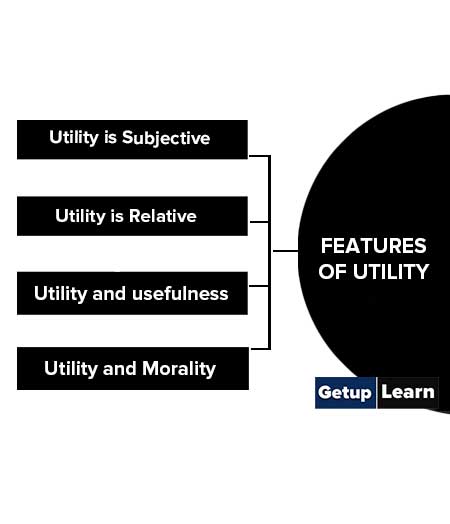
Utility is Subjective
The utility is subjective because it deals with the mental satisfaction of a man. A commodity may have different utilities for different persons. A cigarette has utility for a smoker but for a person who does not smoke, the cigarette has no utility. Utility, therefore, is subjective.
Utility is Relative
The utility of a good never remains the same. It varies with time and place. The fan has utility in the summer but not during the winter season.
Utility and usefulness
A commodity having utility need not be useful. Cigarettes and liquor are harmful to health, but if they satisfy the want of an addict then they have utility for him.
Utility and Morality
The utility is independent of morality. The use of liquor or opium may not be proper from a moral point of view. But as these intoxicants satisfy the wants of the drunkards and opium eaters, they have utility for them.
Concepts of Utility
Let’s discussed the concepts of utility:
- Initial Utility
- Total Utility
- Marginal Utility
- Positive Marginal Utility
- Zero Marginal Utility
- Negative Marginal Utility

Initial Utility
The utility derived from the first unit of a commodity is called initial utility. Utility derived from the first piece of bread is called initial utility. Thus, initial utility is the utility obtained from the consumption of the first unit of a commodity. It is always positive.
Total Utility
Total utility is the sum of utility derived from different units of a commodity consumed by a household.
According to Leftwich, “Total utility refers to the entire amount of satisfaction obtained from consuming various quantities of a commodity.” Supposing a consumer four units of apple. If the consumer gets 10 utils from the consumption of the first apple, 8 utils from the second, 6 utils from the third, and 4 utils from the fourth apple, then the total utility will be 10+8+6+4 = 28
Accordingly, total utility can be calculated as:
TU = MU1 + MU2 + MU3 + _____ + MUn
or
TU = EMU
Here TU = Total utility and MU1, MU2, MU3, + __ MUn =
Marginal Utility derived from first, second, third __ and nth unit.
Marginal Utility
Marginal Utility is the utility derived from the additional unit of a commodity consumed. The change that takes place in the total utility by the consumption of an additional unit of a commodity is called marginal utility.
According to Chapman, “Marginal utility is the addition made to the total utility by consuming one more unit of commodity. Supposing a consumer gets 10 utils from the consumption of one mango and 18 utils from two mangoes, then. the marginal utility of second .mango will be 18-10=8 utils.
The marginal utility can be measured with the help of the following formula MUnth = TUn – TUn-1
Here MUnth = Marginal utility of nth unit,
TUn = Total utility of ‘n’ units,
TUn-l = Total utility of n-i units,
The marginal utility can be (i) positive, (ii) zero, or (iii) negative.
Positive Marginal Utility
If by consuming additional units of a commodity, total utility goes on increasing, marginal utility will be positive.
Zero Marginal Utility
If the consumption of an additional unit of a commodity causes no change in total utility, the marginal utility will be zero.
Negative Marginal Utility
If the consumption of an additional unit of a commodity causes a falls in total utility, the marginal utility will be negative.
Measurement of Utility
The utility is the want satisfying power of a commodity. It is a psychological and subjective concept that is not concerned with ethics or morality. On account of such, characteristics utility cannot be easily measured. It cannot be directly measured. Indirect measurement of utility is possible.
Economists have suggested two methods for the measurement of utility. They are also called two approaches to utility analysis. They are as given below:
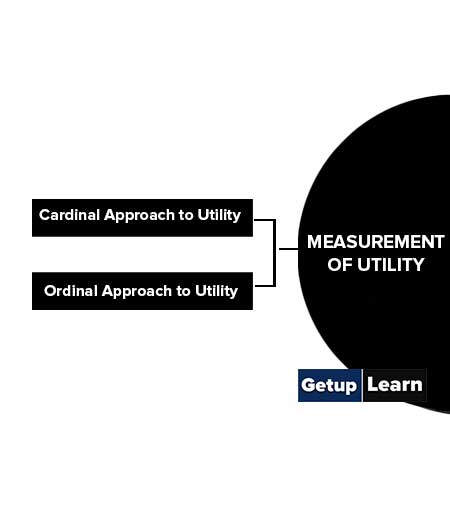
Cardinal Approach to Utility
According to the cardinal approach to utility while purchasing a commodity a consumer has to sacrifice in terms of money and this sacrifice is the measuring of utility. Marshall and other neo-classical economists have developed this approach to utility. Money is the measuring rod of utility.
Higher is the utility higher will be the sacrifice from the consumer in terms of money. When the stock of commodities increases the additional units will give less and less utility to the consumer. Thus, the utility of a commodity derived by a consumer is measured in terms of money.
For example, Mr Mohan is willing to pay Rs. 18 for commodity X, Rs.16 for commodity Y and Rs. 14 for commodity Z, then we can say that commodity X has more utility than commodity Y and commodity Y has more utility than commodity Z, which can be expressed as follows.
X>Y>Z
The method of measuring utility in terms of money is called the cardinal approach. We can measure the utility in terms of money. The utility can be added, subtracted and multiplied with the help of this method in cardinal numbers like 1,2, 3, 4 and so on.
Ordinal Approach to Utility
According to ordinal economists like J.R. Hicks, R.G.D. Allen, FY. Edgeworth and Vilfredo Pareto’s utility is not cardinally measurable and, it can be measured in ordinal numbers like I, II, III and so on. These economists put forward the following arguments against the cardinal measurement of utility:
Utility is a psychological and subjective concept that cannot be measured in numerical numbers.
The mental state and attitude of each individual go under change according to time, country and circumstances. The utility also goes under changes frequently. Hence, utility is not measurable as pointed out by modern economists.
“The measuring rod of utility, as put forward by Prof. Alfred Marshall, “ is money which is not a stable and exact measurement as we find in case of natural and physical sciences.”
According to the ordinal approach to utility, we can put the utility derived from different commodities in order of preference and a comparison can be made. The first preference is for the commodity giving the highest utility and the second and third preferences are for those commodities giving less utility.
On the basis of such a scale of preference, the new analysis for the measurement of utility namely the ordinal utility approach has been propounded and it is based on indifference curve analysis. The cardinal utility approach has been replaced by the ordinal utility approach. However, the cardinal utility has its importance and several laws of economics are based on it.
Law of Diminishing Marginal Utility
The Law of Diminishing Marginal Utility is an important law of utility analysis. This law is related to the satisfaction of human wants. All of us experience this law in our daily life. If you are set to buy, say, shirts at any given time, then as the number of shirts with you goes on increasing, the marginal utility from each successive shirt will go on decreasing.
It is the reality of a man’s life that is referred to in economics as the law of Diminishing Marginal Utility. This law is also known as Gossen’s First Law.
[su_quote cite=”Chapman”]The more we have of a thing, the less we want additional increments of it or the more we want not to have additional increments of it.[/su_quote]
[su_quote cite=”Marshall”]The additional benefit which a person derives from a given stock of a thing diminishes with every increase in the stock that he already has.[/su_quote]
[su_quote cite=”Samuelson”]As the amount consumed by a good increase, the marginal utility of the goods tends to decrease.[/su_quote]
In short, the law of Diminishing Marginal Utility states that other things being equal, when we go on consuming additional units of a commodity, the marginal utility from each successive unit of that commodity goes on diminishing.
Assumptions
Every law is subject to the clause “other things being equal” This refers to the assumption on which a law is based. It applies in this case as well. The main assumptions of this law are as follows:
- The utility can be measured in cardinal number systems such as 1,2,3 _ etc.
- There is no change in the income of the consumer.
- The marginal utility of money remains constant.
- A suitable quantity of the commodity is consumed.
- There is continuous consumption of the commodity.
- The marginal Utility of every commodity is independent.
- Every unit of the commodity being used is of the same quality and size.
- There is no change in the tastes, character, fashion, and habits of the consumer.
- There is no change in the price of the commodity and its substitutes.
Law of Equi-Marginal Utility
The law of equi-marginal utility is based on the law of diminishing marginal utility. This law operates when different units of different commodities are consumed and the consumer tries to maximise his satisfaction with his given resources. The law is called the law of substitution.
The consumer should allocate his resources on different units of different commodities in such a way that in the last the marginal utility of each commodity is equalised.
[su_quote cite=”Prof. Alfred Marshall”]If a person has a thing that can be put to several uses, he will distribute it among these uses in such a way that it has the same marginal utility in all. For, if it had a greater marginal utility in one use than another he would gain by taking some of it from the second use and applying it to the first.[/su_quote]
The above definition of the law reveals that a consumer will attain maximum satisfaction when the marginal utility of all goods purchased is in the proportion to their prices. Marginal utilities are equalized while maximizing the satisfaction of the consumer, which is called the law of equi-marginal utility.
Importance of the Law of Equi-marginal Utility
The importance of the law of equi-marginal utility can be explained as follows:
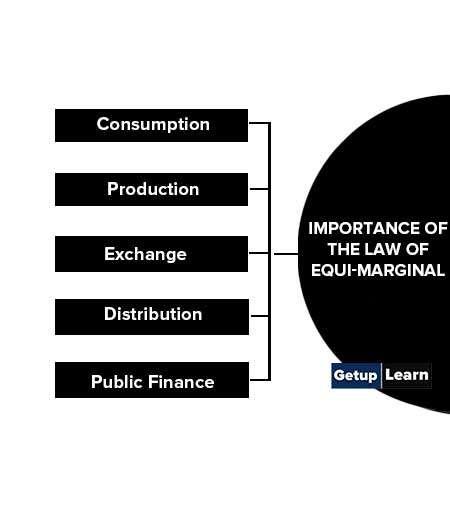
Consumption
If a consumer spends his income, as suggested by this law, on different commodities in such a way that the last unit of money spent on them yields him equal marginal utility, he will be getting maximum satisfaction out of his income.
Production
Every producer aims at earning maximum profit. To achieve this objective he must utilize different factors of production in such a way that the marginal productivity of each factor is equal.
Exchange
Acting upon the law of equity-marginal utility, every person will go on substituting goods giving more utility for the ones giving less utility, till the marginal utility of all becomes equal. The exchange will stop at that point.
Distribution
It refers to the distribution of national income among the factors of production, i.e. land, labour, capital, etc. Distribution is done in such a way that in the long run, every factor gets its share out of national income according to its marginal productivity.
Public Finance
At the time of levying taxes, the finance minister takes the help of this law. He levies taxes in such a manner that the marginal sacrifice of each tax-payer is equal. Then only it will have the least burden on all taxpayers. To achieve this objective, a finance minister may substitute one tax for the other.
Criticism of the Law of Equi-marginal Utility
This law has been subjected to the following criticism:
- Cardinal Measurement of Utility Is Not Possible
- Consumers are Not Fully Rational
- Shortage of Goods
- Ignorance of Consumer
- Influence of Fashion, Customs and Habits
- Constant Income and Price
- Change in the Marginal Utility of Money
- Complementary Goods
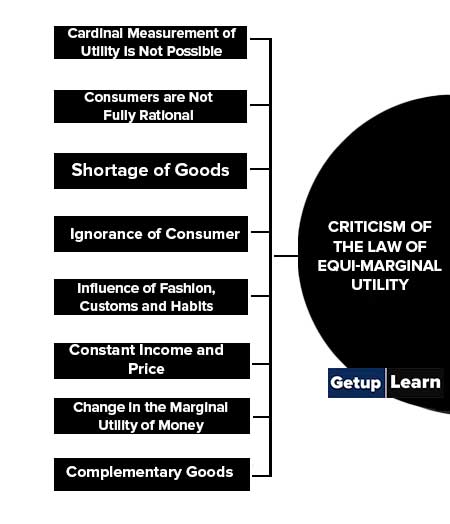
Cardinal Measurement of Utility Is Not Possible
Measurement of utility is not possible. How can a consumer say that he would get 10 utils of utility from the first apple and 8 utils, of utility from the second Unless marginal utility is estimated, application of the law will remain dubious.
Consumers are Not Fully Rational
The assumption that consumers are fully rational is not correct. Some consumers are idle by nature, and so to satisfy their habits and customs, they sometimes buy goods yielding less utility. Consequently, they do not get maximum satisfaction.
Shortage of Goods
If goods giving more utility are not available in the market, the consumer will have to consume goods yielding less utility.
Ignorance of Consumer
The consumer is ignorant about many things concerning consumption. Many times, he is ignorant about the right price of the goods. He is ignorant about the less expensive substitutes that may be way available in the market. He is also ignorant about the different uses of goods.
On account of this ignorance, the consumer fails to spend his income in a manner that may yield him maximum satisfaction.
Influence of Fashion, Customs and Habits
The actual expenditure of every consumer is influenced by fashion, customs, and habits. Under their influence, many times the consumer buys more of such goods which give less utility.
Consequently, he buys less of those goods which give more utility. Hence he fails to spend his income according to this law.
Constant Income and Price
An important assumption of the law is that the income of the consumer and the price of the goods should remain constant. The income of the consumer is limited, as such he cannot increase his satisfaction beyond a particular limit. Likewise, prices being constant, he will get only as much satisfaction as the number of goods that he can buy with limited income. He cannot extend his satisfaction beyond this limit.
Change in the Marginal Utility of Money
The assumption that the marginal utility of money remains constant is also unrealistic. In actual life, the marginal utility of money may increase or decrease. Due to an increase in the marginal utility of money, a consumer will have to rearrange his expenditure on different goods.
Complementary Goods
The law does not apply to complementary goods. It is so because complementary goods are used in a fixed proportion. By using less of one commodity, the use of the other cannot be increased.
FAQ
What is the utility analysis theory?
So long as an article satisfies man’s desire of body or mind, it possesses utility in the economic sense, although this may be pernicious in its effect on the consumers or on others or detrimental to the commodity generally.
What is the short definition of utility?
The utility of a thing to a person at a time is measured by the extent to which it satisfies his wants.
What are the three characteristics of utility in economics?
Following are characteristics of utility which discussed below:
1. Utility Is Not Related With Usefulness or Welfare
2. Utility is Measurable
3. Utility is a Relative Term
4. Utility is Subjective
5. Utility Depends on the Intensity of Want
6. Utility is Concerned with Consumer Goods Only
7. No Physical Shape
8. Utility Does Not Depend on Actual Consumption
9. Rationality of the Consumer.
What are utility and its features?
These are features of utility:
1. Utility is Subjective
2. Utility is Relative
3. Utility and usefulness
4. Utility and Morality.

















